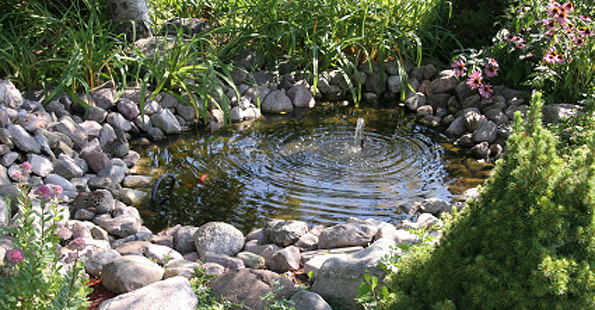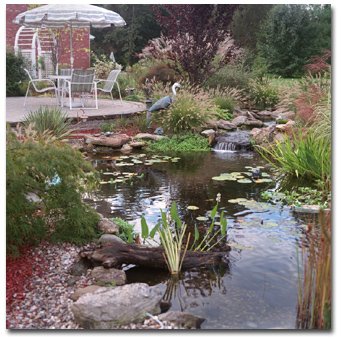1. Good design considers maintenance, and this includes water requirements.
2. All good design requires a clear vision and careful planning. And this good planning depends on a thorough analysis of your property. Take the time to create a base plan, and indicate on it the movement of the sun, the prevailing winter and summer winds, good views and bad, flat areas and sloped, any particularly wet or eroded areas. Check out the condition of your soil.
3. Once you’ve diagrammed what you have, you can begin the fun process of listing the needs and wants for your property. Once you have your wish list, you can begin matching these to your site plan.
- Before continuing we should first note that all plants need more regular watering while they become “establishedâ€, that is, while their root systems grow and are established in the permanent landscape. For trees and shrubs, this can take 1-2 years, depending on conditions and their own rates of growth. For perennials this could be one growing season. Annuals, most vegetables, and lawns continue to need regular watering to maintain peak health and performance. So, consider this when first establishing your new landscape. Even when planting trees and shrubs that are “drought-tolerantâ€, they aren’t really drought-tolerant until they’re properly “established†– which can take some time.
- Second, all plants will perform better when they’re healthy, and a large contributor to health is the soil in which they reside. By providing your plants with the best possible soil, they’ll be able to withstand a greater degree of stress regardless of the weather conditions. Don’t forget your usual maintenance activities, such as mulching, pruning, composting and fertilizing. Strong plants require less care than weaker ones, and they also give your landscape or garden a more attractive look.
- And, finally, all plants will perform their best when planted in conditions that reflect their origins. Although many plants can tolerate, that is “surviveâ€, a range of conditions, they won’t necessarily thrive out of their preferred environment. For example, a river birch (as noted by its name!) prefers moist conditions, and can even tolerate flooding. It may do “just fine†under normal conditions, but will be happiest where the soil stays moist. We refer to this as “right plant, right placeâ€.
Lawn. Determine just how little lawn you really need, and then locate it where it’d be most functional, give it a nice shape. Consider joining these disparate elements together into larger planting beds. Of course, you should choose the best grass type for your area, and keep it properly maintained.
For flowers and bulbs, consider their ongoing watering requirements and choose wisely. Where necessary, consider using extra tough, drought –tolerant annuals such as flowering vinca and lantana to reduce your watering schedule. There are many perennials that are quite “tough†once established, requiring no additional watering beyond what Mother Nature provides….
When considering your trees and shrubs, most trees that you find in Virginia nurseries will do just fine without any extra watering once they’re established. Likewise, many shrubs will do just fine in a wide range of conditions, but it pays to do your research to be sure.
Here are some more tips to help with your maintenance and watering:
- Place your plants in groups according to the amount of water they need. This way, you won’t end up over-or-underwatering any parts of your lawn or garden. The fancy term for this is “hydrozonesâ€. Generally, hydrozones are divided into three categories: those that require regular irrigation (high moisture zones), those that need irrigation only during long dry spells (moderate moisture zones), and those that rarely or never need irrigation except possibly in times of extreme drought (low moisture zones).
- Establish watering priorities. Take care of new and young plantings, then more mature trees and shrubs.
- Map out a set watering schedule – you’ll minimize your water consumption this way. Strive to water in the early morning to take advantage of the cooler temperatures and reduce evaporation.
- Water slowly, deeply and infrequently to avoid water runoff and spot-water areas which dry out more quickly. Make sure your hose or sprinkler does not leak, and avoid placing watering devices where they waste water on your driveway, deck or porch.
- Control weeds. They compete with useful plants for water.
- Shelter container plants by moving them to shady areas. This will reduce water loss due to evaporation.
- Use a drip watering system. This can save up to 60% of the water used by sprinkler systems.
- Consider letting your lawn go dormant; most lawn grasses will rebound when rains return.
- If you have a slope, place lower-water-demand plants at higher elevations, and those that need more water at lower elevations. The water from the higher areas will trickle down to your plants which demand more moisture.



Deprecated: strpos(): Passing null to parameter #1 ($haystack) of type string is deprecated in /home/agriviek8Qv/agriviet.net/public_html/wp-includes/comment-template.php on line 2522